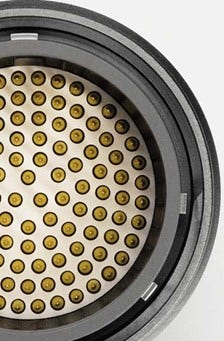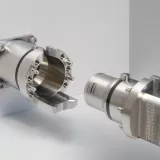The heart of the race

Formula 1 racing, 24 Hours of Le Mans and M for Motorsports... The M series connectors were designed to be used in the harshest environments.
How did the extraordinary success of these new high quality connectors come about? Their designer, Billy Barbey, LEMO’s R&D and Product Support Manager, will answer.
Designed for withstanding operating temperatures from -55 to +200°C, for resistance to the most vi- olent vibrations and shocks as well as to oil and hydrocarbon attack, the LEMO M series connectors were made for hard life. Beyond their impressive ruggedness, the company’s latest products signify a change of direction for LEMO: they are the first LEMO connectors using a ratchet screw coupling mechanism instead of the standard Push-Pull system invented by LEMO 67 years ago.
The M series originated after demonstrating an aircraft connector development to Formula One teams. The compact F series (F for Formula 1) had been in use by some race teams on sensors on the data logging system for many years. However, it became clear that if LEMO wanted to provide con- nectors for much higher vibration applications in the region of the engine, we needed to re-consider our connector design for the purpose. “We were reminded from our discussions with customers that our designs for critical applications within F1 systems should be such that the possibility of a dis- connection during a race must never be permitted. Whilst our F series connectors were being used in many applications on F1 cars – for control sensing and harness connection applications in environ- ments ranging from the harsh temperature and vibration of the gearbox and brakes, to the cooler but otherwise demanding connection of the steer- ing wheel – these connectors were not being used directly on the engines or other primary systems.”
Once the review had been completed, Billy Barbey set to work. “I started by analyzing the compet- itors, then took a sheet of paper and started to make sketches. We just had to have a solution.” This solution was to be found through improving on the concept of MIL-C 38999 connectors, es- pecially used in aeronautics. Their safety ratchet screw coupling system, with its characteristic clicking noise, makes all unintended disconnec- tion impossible, however intense the vibrations may be. LEMO’s R&D manager was inspired by this technology and worked hard to make it even more reliable as well as much smaller.
After a long period of development, numerous prototypes and iterations, the LEMO M series was born. It features an innovative highly secured cou- pling system which needs a much greater force to unscrew the connector from its socket than to mate it. This ensures resistance to the most in- tense vibrations.
The new connector also features an aluminium “Arctic Grip” option, with large external grooves. The reason is to facilitate handling with gloves during intervention in the extreme heat inside the engine bay of a Formula 1, or freezing tem- peratures typically in defence applications. The M series also offers up to 114 contacts inside the same or smaller volume than any other existing connector available on the market. The pin den- sity is much higher than that which competitors can propose. The M series therefore reduces the number of connectors needed, which equals less cost, better reliability, significant space-saving and lighter weight.
With such performance, the M series soon became a success story, with major annual increases in sales since its launch. Today it is available in many differ- ent sizes, housings and contact options, including overmould and backshell fittings with power and fibre optic contacts, and also in USB version. The connector is also manufactured in brass for ships, ocean liners and other marine applications where extreme corrosion resistance is required.

However, whilst the M series is now used in many other industries that require compact, high performance interconnections, it has continued to be increasingly employed in the motorsport industry, the field which brought real success to this LEMO series.
The heart of a Formula 1 car is the Electronic Con- trol Unit (ECU), an extremely expensive system where all electronics data are processed and distributed. Due to the significant space savings provided and the high performance of the con- tacts, the M Series has been adopted for use on the current version of the F1 ECU, with three size 5 connectors containing up to 114 contacts in a 30mm diameter shell being central to the unit.
![]() The FIA objective was to reduce costs for small teams by standardising on the ECU to be used, so they no longer needed to develop their own ECU. This decision meant that LEMO’s high-tech connectors are now fitted on board all F1 cars. Three LEMO sockets on every ECU also implies three corre- sponding LEMO plugs to be connected, along with a range of the LEMO F series connectors on junc- tion boxes and other parts of the system. Stocks of connectors for the F1 teams are held at LEMO in the UK due to many of the teams being based there, as well as at other LEMO locations around the globe in support of the motor racing industry.
The FIA objective was to reduce costs for small teams by standardising on the ECU to be used, so they no longer needed to develop their own ECU. This decision meant that LEMO’s high-tech connectors are now fitted on board all F1 cars. Three LEMO sockets on every ECU also implies three corre- sponding LEMO plugs to be connected, along with a range of the LEMO F series connectors on junc- tion boxes and other parts of the system. Stocks of connectors for the F1 teams are held at LEMO in the UK due to many of the teams being based there, as well as at other LEMO locations around the globe in support of the motor racing industry.
This is not all: after the F1, LEMO is aiming at be- coming the standard in another prestigious cham- pionship, the American NASCAR. In the meantime, the M series has passed a different test, in the leg- endary 24 Hours of Le Mans. The new Rebellion Racing and Oreca R-One cars are packed with M connectors. A full-scale endurance test and the beginning of new records for LEMO.



